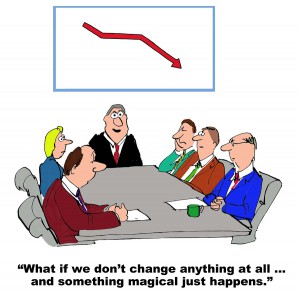There’s no question that Lean Six Sigma has earned its position as one of the most important management methodologies ever devised for operational improvement.
Its deployment alone speaks to it: Lean manufacturing is employed by some 70% of all U.S. plants, and demand for those schooled in its principles is skyrocketing. One recruiting firm has seen a doubling in demand for Lean and Six Sigma talent in recent years.
Still, while non-manufacturing sectors from healthcare to banking are starting to test the Lean waters, a great many businesses still resist. To a significant extent, it stems from the stakeholders’ inability to separate fact from fiction – if not a strong reluctance to step out of their comfort zones.

So what are some of the most common facts, fallacies and general misconceptions that keep businesses from sipping the Lean Kool Aid? Let’s take a look at six of the most common:
#1. It’s just a fad. We’re still focused on TQM.
Actually, no. “Fad” implies here and gone. Lean is still going strong, although evolving, from origins that go back to the early 1900s. Think Henry Ford, Western Electric’s Walter Shewhart, or Toyota’s Shigeo Shingo.
What has distinguished it from other management methodologies are three characteristics that make it more relevant today than ever before: its emphasis on the customer, a strong reliance on data and analytics to buttress sound decision-making, and its focus on speaking management’s language – can you say “return on investment”?
#2. We tried it once. It didn’t work.
Maybe not, but was the fault in Lean or was it in the thinking, rigor and support behind it? The fact is that whether it’s Lean, Six Sigma, TQM or Process Re-engineering, any methodology is only as good as the people managing it and the processes they entail. Any number of factors can lead to Lean project failure, from a lack of leadership commitment, to a failure to define success, to how projects are chosen and results tracked and shared.
Find champions, engage customers and employees alike, and establish a clear vision and definition of the problems you’re trying to solve. And try again.
#3. Sorry, we just don’t have the time to put against a big, complex initiative like this.
Really? A very good argument for this can be found in the Henry Ford quote: “Time waste differs from material waste because there can be no salvage.”
Seeing Lean projects as a time suck is short-sighted, given the long-term value rendered by investing in developing the knowledge of how, when and where Lean can make a difference.
#4. The costs of putting a Lean program in place are prohibitive.
This doesn’t have to be the case. Even a one-day Yellow Belt training session on the fundamentals is sufficient to create a basic project. But smart managers don’t see Lean as a “cost.” It’s an investment in the business.
Ultimately, hiring certified Black Belts, training teams at other levels and investing in relevant software (e.g. for ) will pay off. Some experts say investment in the right project will yield a five- to 10-times return in the first year.
#5. We don’t have the kind of employees who can tackle programs as complex and sophisticated as Lean.
Capabilities in statistics and advanced mathematics can be helpful in carrying out Lean projects, but they are not mandatory. On the whole, the principles are straight-forward and the tools are generally easy to use – whether your team is comprised of machine operators or engineers.
Part of what makes Lean so powerful is how “new” eyes are enlisted to identify waste, whether by identifying process gaps, redundancies or bottlenecks, or brainstorming, or asking “Why?” five times to get to root causes of problems. Once employees are engaged and adopt the customer perspective, their contributions can be huge.
#6. Lean is really a manufacturing thing. It’s not applicable to our service business.
Wrong again! Any number of businesses involved in providing services have found Lean hugely beneficial, like AT&T, Bank of America and Wal-Mart. Hospitals use it to improve everything from patient care and safety to streamlining routine practices. Banks use it to improve loan processing. Other businesses use it to improve job training.
Lean’s principles are applicable to any sector where there’s waste in some way, shape or form and, in fact, the service industry has more waste than manufacturing due to the non-tangible nature of its deliverables.
Lean Six Sigma may not be the silver bullet for everything that ails a business today. But its underlying principles are relevant to an expanding community of smart businesses and their managers. Separating the fact from fiction is the first step to exploring the possibilities and finding success with it.
You may also enjoy: 6 Persistent Lean Six Sigma Myths – And Why They’re Bogus



